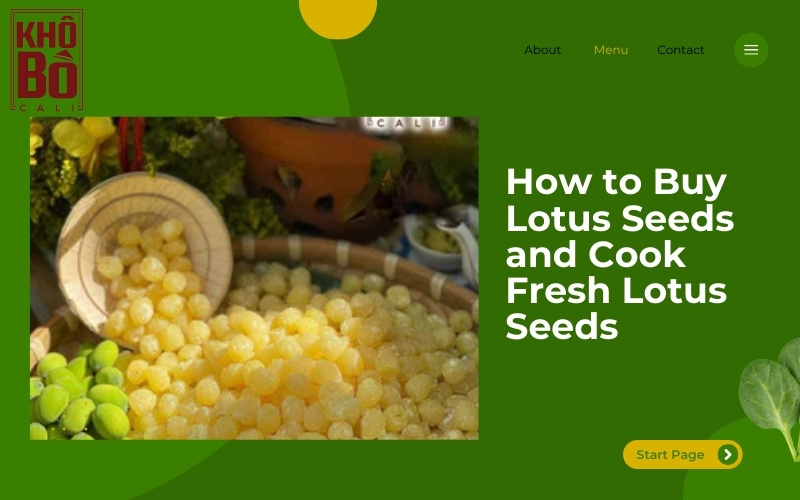Lotus seeds are a versatile food that can be eaten raw or cooked. Dried lotus seeds can be prepared like popcorn and enjoyed as a snack. They are harvested in August and September, then sun-dried. There are two main types of lotus seeds: those with white shells and those with brown shells. The shell, membrane, and bitter germ of the white lotus seeds are removed during harvesting. The brown lotus seeds retain their shell and membrane, which develop as the seeds reach full maturity. If you’re looking to buy lotus seeds, understanding these types can help you choose the right one for your needs.
Understanding Lotus Seeds
The Origin of Lotus Seeds
The lotus is an aquatic, herbaceous flowering plant. Its flowers come in a variety of colors, ranging from pure white to red, light pink, yellow, purple, and even blue. The lotus is one of the few plant species that can regulate the temperature of its flowers, maintaining it within an optimal range to attract insects for pollination. Lotus seeds are found inside the seed pod of the lotus flower. After the flower withers and the petals fall, only the small pod remains. This pod, shaped like a showerhead, contains numerous lotus seeds.
Lotus seeds are a versatile food that can be consumed either raw or cooked. Dried lotus seeds can even be prepared like popcorn. They are typically harvested in August and September and then sun-dried. There are two main types of lotus seeds: those with white shells and those with brown shells. The shell, membrane, and bitter germ of the white lotus seed are removed during the harvesting process. The brown-shelled lotus seeds retain their outer membrane, which forms as the seed matures.
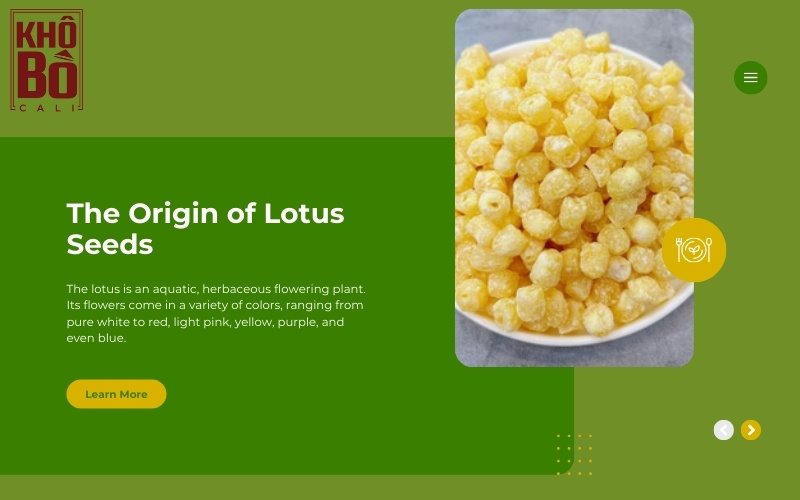
Dried lotus seeds are widely sold in Asian markets. These seeds usually have a hard and coarse texture, so it is recommended to soak them overnight before cooking. They are commonly added to dishes like soups. Fresh lotus seeds are sold with the green embryo still intact. Therefore, before cooking, it is necessary to peel off the shell and remove the green germ in the center.
Apart from the seeds, every part of the lotus plant is edible and serves various purposes. Lotus stems are often used in salads, while the stalks are commonly cooked as vegetables in soups, stir-fries, or stews. The large leaves are ideal for wrapping sticky foods like rice, as they do not cling to the food. Dried lotus leaves are also used to make lotus leaf tea, which is popular for weight loss. Young leaves can be used like regular vegetables.
The beautiful and pure lotus flowers are often used for decoration in homes or placed in sacred spaces such as temples. The petiole (leaf stalk) is also edible, and its fibers are used to make wicks for oil lamps and even to weave fabric. Textiles made from lotus fibers are believed to have healing properties.
And finally, the lotus seed—the star of this article—needs no further introduction. It can be used in an impressive variety of both savory and sweet dishes, such as lotus seed stewed with pigeon, lotus seed sweet soup, and lotus seed milk. If you’re planning to buy lotus seeds, knowing how they are harvested and used will help you better appreciate their culinary and cultural value.
Types of Lotus Seeds on the Market
You may wonder—if lotus can be grown anywhere, wouldn’t all lotus seeds be essentially the same? So how exactly are lotus seeds classified? I divide them into two main categories based on: harvesting methods and how they are used by consumers.
Based on the harvesting method, lotus seeds are classified into brown lotus seeds and white lotus seeds. Brown lotus seeds are harvested when the lotus pod has wilted or is nearly dry, so the silk-like membrane sticks to the seed, giving it a brown color. The germ (or heart) of a brown lotus seed can only be removed by splitting the seed in half. On the other hand, white lotus seeds are harvested from green lotus pods that still contain nearly mature seeds inside. These seeds can be peeled, the outer silk removed, and the green germ extracted using a toothpick or pointed tool.
Additionally, lotus seeds are commonly divided into fresh lotus seeds and dried lotus seeds on the market. Fresh lotus seeds are usually dried to reduce their moisture content to below 10% for easier preservation and transportation. Depending on the processing method, the form in which they reach consumers may vary. However, both types retain the same nutritional content and health benefits that are naturally present in lotus seeds.
If you’re planning to buy lotus seeds, understanding these classifications can help you choose the right type for your culinary or health needs.
Benefits of Fresh Lotus Seeds
Nutritional Value of Fresh Lotus Seeds
Lotus seeds, also known as lotus nuts, have a sweet taste and neutral nature, and they contain many valuable nutrients. In traditional Eastern medicine, lotus seeds are considered a delicious and nutritious food as well as a precious medicinal ingredient that calms the mind, nourishes the kidneys, strengthens the spleen, and can improve negative conditions such as diarrhea, insomnia, indigestion, bloating, poor appetite, and thirst caused by high fever or dehydration.
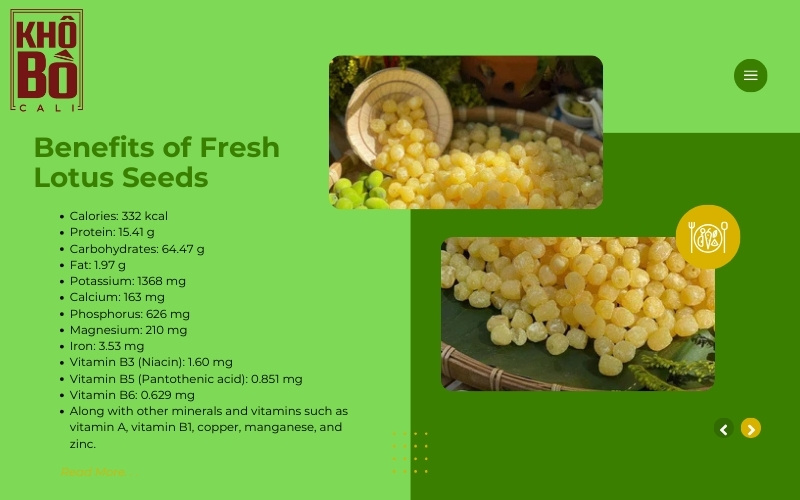
According to the USDA, in 100 grams of dried lotus seeds, there are:
-
Calories: 332 kcal
-
Protein: 15.41 g
-
Carbohydrates: 64.47 g
-
Fat: 1.97 g
-
Potassium: 1368 mg
-
Calcium: 163 mg
-
Phosphorus: 626 mg
-
Magnesium: 210 mg
-
Iron: 3.53 mg
-
Vitamin B3 (Niacin): 1.60 mg
-
Vitamin B5 (Pantothenic acid): 0.851 mg
-
Vitamin B6: 0.629 mg
Along with other minerals and vitamins such as vitamin A, vitamin B1, copper, manganese, and zinc.
Given these nutrients, it’s no surprise that lotus seeds are widely used in daily life as a valuable health food, rich in energy, protein, minerals, and vitamins in balanced amounts.
Moreover, lotus seeds contain an enzyme called L-isoaspartyl methyltransferase, which has anti-aging properties by repairing damaged proteins in the body. Eating lotus seeds benefits the skin by helping restore vitality and rejuvenate the skin. They are also rich in kaempferol, a natural flavonoid with many benefits, including anti-inflammatory effects. This flavonoid is especially effective in reducing inflammation of the gums, particularly in the elderly. To better understand the many benefits that fresh lotus seeds bring, please continue reading this article.
Benefits of Eating Fresh Lotus Seeds
-
Improves Sleep
Lotus seeds help improve insomnia. It’s well-known in Eastern medicine that lotus seeds act as a sedative. Nutrition experts say lotus seeds contain alkaloids and aromatic glucosides that promote calmness. Eating lotus seeds stimulates insulin secretion from the pancreas, making it easier to fall asleep and improving sleep quality. They also relieve stress and reduce anxiety effectively. -
Oral Care
Common oral issues include bleeding gums, mouth ulcers, and canker sores. By adding lotus seeds to your diet, you can reduce these problems and soothe gum irritation caused by improper oral hygiene, thanks to natural anti-inflammatory compounds like kaempferol and flavonoids found in lotus seeds. -
Helps Stabilize Blood Pressure
Alkaloids with antispasmodic properties and isoquinoline compounds in the lotus seed heart help dilate blood vessels and lower blood pressure. Including lotus seeds in your diet can help manage high blood pressure. -
Strong Antioxidant Effects
Lotus seeds contain antioxidants that help fight inflammation and infection. For decades, traditional Chinese medicine has used lotus seeds to heal wounds and prevent infection spread. The rich kaempferol flavonoid in lotus seeds has anti-inflammatory properties and can treat mouth pain and ulcers effectively. Lotus seeds have long been recognized for their soothing and antibacterial effects. -
Supports Weight Loss
Nutritionists highlight lotus seeds as a natural appetite suppressant. So, does eating lotus seeds help with weight loss? Yes, it does. Lotus seeds are known as a “golden food” for health and effective weight management. Besides low calories, lotus seeds are rich in protein, potassium, phosphorus, and magnesium—nutrients that act as enzyme catalysts and cellular components to help you feel full faster and speed up fat burning, especially belly fat. Moreover, lotus seeds contain very low saturated fat, cholesterol, and sodium—factors that contribute to obesity and related health problems.
Some suitable lotus seed dishes for weight loss include:
-
Lotus seed and red date sweet soup
-
Lotus seed and longan sweet soup
-
Lotus seed and papaya sweet soup
-
Lotus seed milk
-
Brown rice porridge with lotus seeds
-
Beauty Benefits
Seeds, in general, provide energy to promote collagen production and restore essential proteins to maintain youthful skin. Lotus seeds contain a special enzyme, L-isoaspartyl methyltransferase, which repairs damaged proteins in the human body, helping keep the skin young. Additionally, their anti-inflammatory properties reduce excess oil, unclog pores, and prevent acne formation. Eating lotus seeds is an effective way to maintain smooth and radiant skin. Their carbohydrates, lipids, calcium, phosphorus, and vitamins also help exfoliate dead skin cells and improve blood circulation for brighter, smoother skin. -
Nourishing for Pregnant Women and Children
For pregnant women, lotus seeds play an important role by providing essential nutrients such as protein, lipids, carbohydrates, calcium, phosphorus, iron, and vitamins B1, B2, PP, and C. Lotus seeds are also a good protein source that supports fetal nervous system and brain development. Obstetricians recommend lotus seeds for pregnant women to promote a healthy pregnancy because of their rich energy and abundant vitamins and minerals. The carbohydrate, protein, and various vitamins like A and C in lotus seeds help stabilize pregnancy, prevent miscarriage, and stimulate fetal brain development for comprehensive growth.
Important Notes When Consuming Fresh Lotus Seeds
Although fresh lotus seeds are known as a very easy-to-eat food for almost everyone, there are a few important points you should keep in mind when consuming them:
Recommended daily amount:
For children, it is advisable to give them about 1 to 2 grams per day, which can be ground into a fine powder or cooked into porridge. While lotus seeds offer many health benefits, eating too many can cause some unwanted side effects such as constipation, bloating, and indigestion.
For adults, it is recommended to consume only about 28 grams of lotus seeds per day. Eating too many lotus seeds, especially those containing lotus embryos (the green core), can cause fatigue and irregular heartbeats. Nutrition experts also advise not to eat large amounts continuously for a long time or for more than 7 days to avoid undesirable side effects. After a few days of consumption, take a break to allow the body to process and eliminate before resuming.
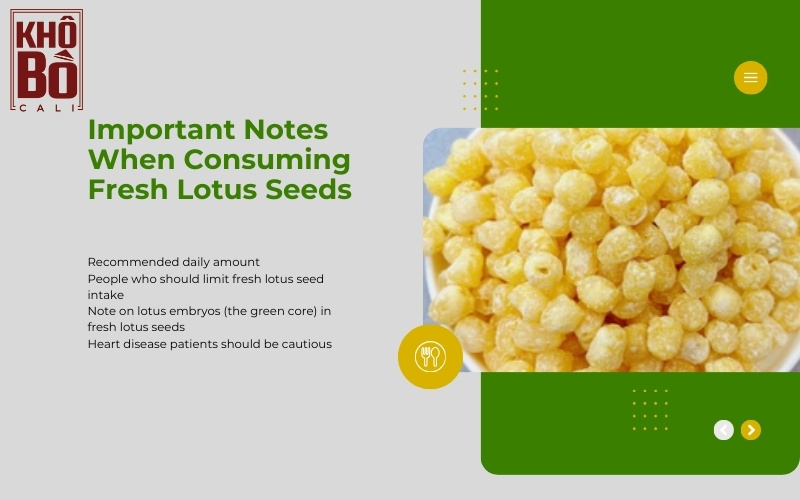
People who should limit fresh lotus seed intake:
Lotus seeds are generally safe and non-toxic but should be limited if you have conditions like constipation, indigestion, or bloating. Although lotus seeds support digestive function, they should only be used when suffering from diarrhea or stomach pain. Continuous absorption of the vitamins and minerals in lotus seeds can overload the system and worsen bloating.
Note on lotus embryos (the green core) in fresh lotus seeds:
The lotus embryo is known as the main ingredient to treat insomnia and difficulty sleeping and is often used in sedative medicines. However, lotus embryos are quite bitter and hard to eat, so they are usually removed to improve the taste of dishes. If you want to use lotus embryos for sleep support or sedation, you should only consume processed lotus embryos. Eating too many fresh lotus embryos at once can be toxic. When combined with medicinal herbs, they should be roasted (dry-fried) before use in a controlled amount.
Heart disease patients should be cautious:
People with heart conditions should avoid eating lotus embryos together with lotus seeds or should limit the quantity. Lotus embryos contain a high amount of alkaloids that can affect the heart and may cause heart pain or stroke if consumed excessively.
Lotus seeds are a rich source of essential nutrients for the body. However, it is important to consume them with care to maintain an effective and safe intake. Eat lotus seeds in moderation, avoid excessive consumption, and combine them in meals to enhance flavor.
Buying Fresh Lotus Seeds
Price of Fresh Lotus Seeds
On the market, lotus seeds are sold in many places. You can easily find them at local markets, supermarkets, or food stores. However, the most important thing is to choose a reputable seller. Fresh lotus seeds are typically sold at around 180,000 VND per kilogram and can go up to 200,000 VND per kilogram. Despite the price, many homemakers are still willing to buy them due to their outstanding health benefits. As for dried lotus seeds, prices vary depending on the brand and added ingredients, usually ranging from 300,000 to over 400,000 VND per kilogram (estimated prices).
Tips for Choosing Fresh Lotus Seeds
Buy directly from lotus ponds:
It’s best to purchase lotus seeds right after they’ve been harvested. At this time, the seeds are still inside the seed pod, allowing you to freely select the best and freshest ones. Alternatively, you can buy from small vendors at local markets. However, buying directly from the lotus pond is usually much cheaper since you’re buying at the original price. Typically, unpeeled lotus seeds cost around 60,000 VND/kg, while peeled seeds cost about twice as much, around 120,000 VND/kg. Fresh lotus seeds that have had the bitter green core (lotus embryo) removed are usually sold for around 160,000 VND/kg.
Buy unpeeled fresh lotus seeds:
To maintain the freshness and flavor, it’s recommended to buy lotus seeds that are still in their shells. Once purchased, you can sun-dry the seeds and avoid letting them get wet. Once dry, store them in a sealed jar for longer preservation. Here’s a tip to peel the seeds and remove the embryo at home using just a toothpick: First, make a small cut on the seed with the toothpick. Then, break off the sharp end of the toothpick and use the blunt end to push through the seed from the opposite side of the cut, following the vertical direction. The lotus embryo will be pushed out through the opening without damaging the seed’s shape.
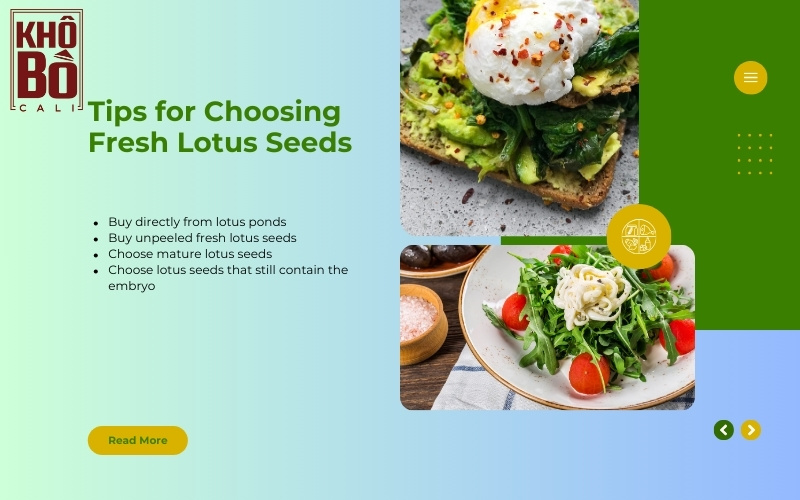
Choose mature lotus seeds:
When buying fresh lotus seeds, choose mature ones. Avoid young or underdeveloped seeds. Mature seeds are usually plump, with an ivory white or deep yellowish color. These seeds, when cooked, release a distinctive aroma and have a delicious, tender texture without being tough.
Choose lotus seeds that still contain the embryo:
As we know, a lotus seed consists of two parts: the seed and the embryo (a small green shoot inside). This embryo has calming properties and is used to treat insomnia, nervous exhaustion, and sleep disorders. When you buy lotus seeds that still contain the embryo, you can use the seeds for cooking and the embryos for making tea, which is great for your health. Lotus embryo tea helps cool the body, calm the mind, and lower blood pressure.
I would also like to emphasize that if you have the chance to visit a lotus pond, take the opportunity to buy fresh lotus seeds on the spot, as they will be of the highest quality and flavor. Especially when used in stews or sweet soups, they offer a rich, nutty taste and soft texture without being chewy. Lotus seeds are a prized food in Vietnam, known for their nutritional value and long-standing popularity. However, not everyone knows how to choose high-quality fresh lotus seeds. I hope that with these helpful tips, you’ll be able to select the best lotus seeds for your family.
Looking for a delicious and ready-to-eat lotus seed product?
If you don’t have time to prepare fresh lotus seeds yourself, why not try Khô Bò CALI’s Premium Lotus Seed Jam? Made from carefully selected mature lotus seeds, our jam is slow-cooked with just the right amount of sweetness to preserve both flavor and nutrients. Each bite is soft, fragrant, and melts in your mouth — perfect for family gatherings, gifts, or simply enjoying with a cup of tea.
Khô Bò CALI is proud to offer high-quality, handmade lotus seed jam with no preservatives or artificial coloring — just the natural goodness of real ingredients.
👉 Order now via our website or message us on Facebook to enjoy the true taste of Vietnam’s traditional sweets, crafted with care by Khô Bò CALI.
KHÔ BÒ CALI
Address: 9511 Bolsa ave westminster CA 92683
Phone numbers: +1 (714) 452-7679 / +1 (714) 234-6899
Email: [email protected]
Website: https://khobocali.com/

